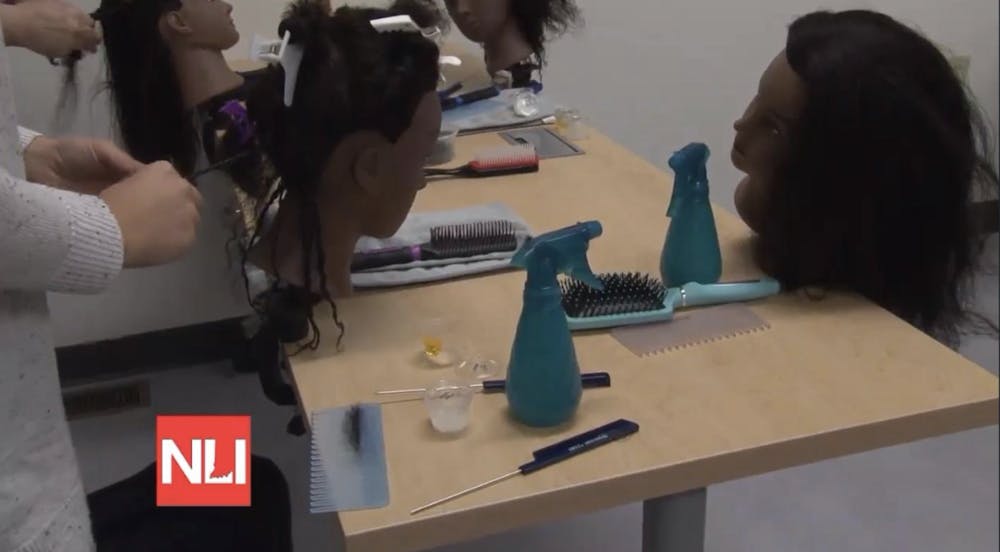MUNCIE, Ind. – One hand grips a spray water bottle and douses a kinky curl with droplets. Two hands rub a shiny oil together before combing it through the ringlet. Finally, a moisturizing cream is applied thoroughly. The method is called LOC, and it stands for Liquid-Oil-Cream. It is one of the two different methods that Erica Robinson, a woman with blonde, fine hair, explains in her biracial hair care class.
Robinson, salon owner and stylist at Beautiful People Salon & Education, started her own biracial hair care classes earlier this year on Feb. 17.
Robinson’s educational workshops on biracial hair care are a resource for families and loved ones to learn how to take care of biracial hair textures.
In each class, students learn about hair types and different methods for care. Robinson teaches three simple hair styles that can be done on boys or girls. Additionally, attendees receive hands-on experience and a take-home kit with the products used in the class.
Robinson started the classes because she realized there was a cultural gap in beauty school education.
“It is a very Caucasian/white dominant world in the beauty school industry,” Robinson said.
In cosmetology schools, Robinson said that predominately white schools tend to teach how to style white hair textures, predominately Black schools learn how to care for Black hair and schools with both ethnicities tend to learn more about white hair textures.
When Robinson was in school, she attended predominately white schools. There were only three thin chapters in her textbook related to ethnic hair. While two of them contained practices for all hair, including perming and relaxing as well as wigs and extensions, only one of the chapters explicitly honed in on ethnic hair.
At the time, Robinson didn’t notice the gap in the industry. It wasn’t until she gave birth to her own biracial children, that she realized she didn’t know what she was doing.
She tried a hodge-podge of products to find what worked for her kids, spent countless hours perfecting the correct method for detangling, and asked lots and lots of questions.
Even when she asked questions for help, she ended up with a range of different answers. Robinson learned that there is no one right answer.
As a mother and grandmother of biracial children, she needed a biracial hair care class when her kids were born. She felt like techniques for Black hair were not taught enough.
Through trial and error, Robinson began a class to help people in her community learn more about biracial hair textures. She realized from the community that there was a greater target audience awaiting help.
Now, Robinson realizes the importance of teaching foster families, teachers and students.
Community Response
In the 42 children Malena Hall has fostered since 2018, she has seen a range of hair textures. She sought out Robinson’s class to learn the best techniques to care for hair different from her own.
In Robinson’s class, she learned she was doing a lot of things incorrectly.
After taking the class, Hall felt a lot more confident about what products to use and what not to do.
Right now, she hopes to learn how to help one of her kids with his hair.
“I have a kiddo right now who is 8, and his hair is a mess. I’m just trying to get it back to where it needs to be,” Hall said.
Hall suggests that other people who may be in her situation find a class like Robinson’s.
Not only have foster parents become a primary target for Robinson, but also teachers.
Robinson found that kids were going to school with unkept hair because their guardians could not do hair, and teachers were wanting to help. She acknowledged the importance of a kid’s self-esteem when it comes to their appearance.
“I think not only do we need to look at culture, but also just the industry … and people as a whole and how can we help people feel beautiful,” Robinson said.
In a study about hair bias in school by Afiya M. Mbilishaka and Danielle Apugo, embarrassment and anxiety were reported as a frequent emotional reaction from negative hair experiences, leading to discomfort in school. Fifty six African American women shared memories of distressing hair experiences that led to gender and racial marginalization.
The study found that African American girls use their school environments as an outlet for self-expression; however, if they experience micro-aggressions, it can impact their well-being.
Robinson found that teachers in the community wanted to make sure their students didn’t experience bullying in class because of their hair. They asked Robinson what hair products they should keep in their desks.
Future Goals
Today, the classes are 2.5 hours and are $80 per family. Robinson suggests that anyone who attends brings family or friends to learn as well.
With the help of sponsors like Meridian Health Services, Family Resource Center, Metanoia Foundation, Ivy Tech and TRC Head Start, Robinson is able to buy supplies, pay partners and facilitate free classes.
Since Robinson’s first class in February, she has expanded her scope and held a series called Transformational Beauty during Pride month. The classes focused on feminine, masculine and androgynous expression. This was another way for Robinson to stress the importance of self-esteem and self-expression.
Robinson plans to expand her classes into hair schools. She also wants to expand outside of Muncie and include other cultures that aren’t taught in schools. Robinson is still looking for sponsors for future classes.
“The beauty industry is huge and there are so many different aspects that people don’t think about every day and it’s growing, growing, growing,” Robinson said.
Contact Katherine Sehgal with comments at klsehgal@bsu.edu






